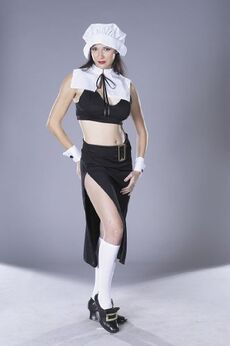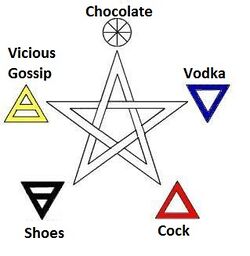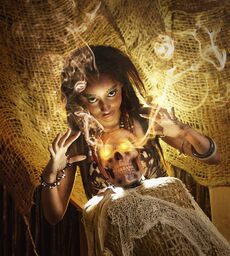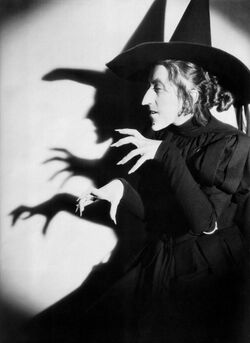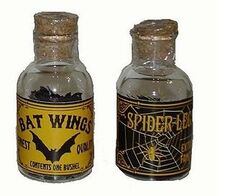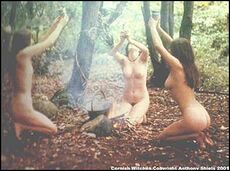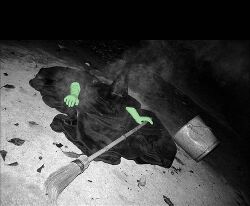Salem witch trials
Between 1692 and 1693 Massachusetts was gripped by an episode of witch fever that saw more than 150 people arrested, often for no better reason than a green and warty complexion. Most of the accused were executed by hanging, though one was crushed beneath a house flown specially from Kansas. [1] At least five others died in prison awaiting trial, most from dysenteric fevers or eye-of-newt poisoning. By the time the panic died down, twelve months after it had begun, women of all ages and social-standings were being accused of involvement in black magic simply for being eccentric, widowed or sexually involved with Satan.
While witch fever had been commonplace in medieval Europe, and witches had been previously executed in New England, it remains a mystery why Massachusetts should be so spellbound at this period. Suggestions as to the cause have ranged from hallucinogenic ergot in rye-bread, a future-echo of the McCarthyite era of Reds under the beds panic, or the lack of anything on television in the late seventeenth century[2]. Nevertheless, Massachusians can take pride that the law was applied both vigorously and with rigor at all points, and the witch-trials’ standing has remained so high for so long that over the centuries it has been adopted as a model of jurisprudence by North Korea, Nazi Germany and Arkansas.
Early Days
Salem had long been known for the fractious relationships between its inhabitants. Bickering about property-rights was common-place and frequently arguments had to be settled in court or by turning one of the aggrieved parties into a toad. The appointment in 1690 of Samuel Parris as clergyman did little to help.
“The Reverend Parris didst intervene oft-times in our boundary dispute with the Plovers family,” wrote Goodtimes Glover recalling the lead-up to the witch trials. “But wouldst commit himself first to one side then to the other contingent upon which or other of the aggrieved parties wore the largest hat! For Reverend Parris was oft heard to say that hatliness is next to Godliness.”
Certainly the initial spark of the incident could not have occurred had Reverend Parris not have been appointed. The first victims of "witchcraft" were his 9 year old daughter Betty and her 11 year old cousin Abigail Williams. Both girls were racked with fits beyond those experienced by anyone in the community before, both frothed at the mouth, screamed and shouted incomprehensible words while contorting their bodies into unnatural positions. Eventually, Samuel Parris was so fearful of their behaviour that he tied both to their beds to confine them to their rooms. As he later reported in his account of the events, “Milliner of God”:
“Fortunately, their armoires did contain plentiful supply of suitable restraints and I gave thanks the Lord that I hadst seen fit to restrain both wenches in such-like a manner so frequently over the long, lonely winter. Betty didst demand a crucifix so violently that I had a servant manufacture one, there being no room for such Papist frippery in the Houses of the Holy. Instantly she didst snatch it from mine hand and proceed to stab herself with it abdominally whilst screaming “Let Jesus have un-lawful carnal knowledge of thee”.”
The local apothecary, William Griggs, examined the girls but could find no hint of physical injury to them “beyond that which can be expected in girls who share dwellings with widowed clergymen”. Soon, however, other girls began to suffer similar symptoms. Later in the month the Reverend Deodat Lawson, who had witnessed the fits of Betty and Abigail, preached a five hour sermon on the evils of witchcraft and found himself repeatedly interrupted by “young ladies possessed by The Devil uttering unearthly demonic snoring and yawning noises.”
Arrests and Accusations
Soon three women were arrested and formally accused of witchcraft. There was little or no evidence against any of them and they appear to have been typical victims of a post-Medieval, male-dominated society fearful of women. Sarah Good was a homeless woman without hope of advancement but a popular figure with children who often begged for rides on her broomstick or gave her gifts of leftovers to feed her pride of stray cats, most of them black, all of them English-speaking. Goodwife Osborne was notorious for avoidance of church services. Summoned to a local consistory court to explain almost a year's non-attendance she had escaped with a fine only by providing evidence of prior coven-commitments. Tituba was a Carrib-Indian slave and was so instantly under suspicion due to her exotic ethnicity as well as her tall, pointy black hat. She too was a popular figure with local children who only three years previously had helped to raise the funds necessary for meringue repairs on the roof of her gingerbread cottage.
March saw further accusations in Salem with Martha Corey, Dorothy Good and Rebecca Nurse arrested for public cackling. The mounting hysteria began to spread to neighbouring communities and Rachel Clinton was seized in nearby Ipswich for excessive wrinkliness. There seemed to be no pattern or reason to the accusation, though Martha Corey may have drawn attention to herself by voicing scepticism about the credibility of evidence provided by minors. "Milliner of God" records:
“Mistress Corey said that if Goodwife Osborne were guilty then any woman who fattened up children for the oven could likewise be accused of witchery. And had she not herself fattened up many a child for Christmas. And did cold cuts of the identical twins she had served for Thanksgiving not yet lie within her pantry.”
Prosecutors were also concerned that she swore her oath to tell the truth with the fingers of one hand crossed, and the first and fourth fingers of the other raised. Reverend Parris reported that:
"When in chapel she did frequently show an unnatural interest in candles that would have made me suspicious that she had fallen prey to Popery, though the unmarried ladies of the parish did oftentimes attempt to smuggle candles home with them. When Mistress Corey's house was raided, evidence of an immoral lifestyle did present itself in moments. For shame that a lady of our God-fearing community could so frequently drink herself insensible! But why else did we find thirteen human skulls hollowed-out into drinking vessels and stained red with stolen communion wine?"
Once Martha Corey had been arrested the contagion seems to have spread throughout the surrounding Puritan communities unchecked. Local magistrates were soon inundated with accusations of witchcraft, most disgruntled husbands who felt that their middle-aged wives' jealousy of their maid-servants could only be demonically inspired.
Mounting Hysteria
In April Sarah Cloyce was arrested for causing her step-daughter to fall asleep for a thousand years by pricking her finger with a poisoned needle. Next day Elizabeth Proctor joined her, jointly accused of possessing an enchanted mirror and "not being ye fairest of them all". When John Proctor objected to his wife’s arrest, he too was arrested. The court refused to accept his testimony that Elizabeth’s incessant nose-twitching was due to hay fever. They further refused to accept that the transmutation of court stenographers into mice was coincidental.
By April 20th the whole county was in uproar and soon Martha Corey’s husband, Giles, found himself in a cell for appearing in public improperly dressed. Puritan ethics demanded plain black clothing buttoned up to the neck. Corey’s nakedness as he danced anti-clockwise under the full moon in the company of twelve virgins was seen as scandalous. Corey later refused to enter a plea in court to avoid confiscation of his property. At the time a trial could not commence until the accused denied the crime and so the court ordered him to suffer the ordeal of pressing until he did so. This involved placing the accused beneath a board and slowly adding rocks until lack of breath caused the victim to submit and enter a plea.
“When around 600 pounds of stone had been added Master Corey did cry out in his anguish “Wait!”. The gaoler, mistaking Corey’s entreaty for enthusiasm, did instantly jump upon the board to add his own weight, as did his helpers. Master Corey did most unhappily die, his body disappearing in a cloud of green smoke.”
Even this tragedy did not stop the hysteria spreading. Abigail Hobbs, Bridget Bishop and Mary Warren were arraigned and given the traditional witch-test of ducking in Massachusetts Bay. All three women are reported to have melted on contact with the water before any judgement could be made. Deliverance Hobbs avoided the same fate only by levitating back to shore where she was forced to confess and name her accomplices. Of the fifteen she accused, all were executed except Sarah Wildes who was released on compassionate grounds having been found to be over 700 years old; William Hobbs, Nehemiah Abbott and the Reverend Burroughs were rescued by an army of brain-washed minions; Sarah Bishop and Dorcas Hoar were released by flying monkeys.
Accusations continued to pour in, but some of those named began to evade apprehension. Multiple warrants were issued before John Willard and Elizabeth Colson were apprehended sitting in a ring of toadstools, apparently unaware that their charm of concealment would be less effective by moonlight. George Jacobs and Daniel Andrews escaped by taking on the form of their familiars and becoming indistinguishable from numberless other burrowing owls in the area. They were never seen again and are thought to have perished in the summer logging season.
Oyer and Terminator
By May 30th a further 36 warrants had been issued and a total of 62 innocent women stood accused of witchcraft at peril of their lives. A special court of Oyer and Terminator (from the French for "Flog 'em and Hang 'em") was set up to investigate the accusations. The first to be tried was Bridget Bishop who was swiftly condemned and executed by hanging on June 10, 1692, by strangulation on June 11th, drowning in Holy Water June 13th and finally by fire on June 15th.
Much of the evidence presented would not be accepted in court today, being “Spectral Proof” – statements from witnesses that the accused had appeared as an apparition and tortured them. Modern courts will accept Spectral Proof only if the apparition has been captured in an ecto-containment unit, generally by use of a portable neutrino gun. In common with many of the subsequently accused, Bridget Bishop admitted that she may have appeared as a vision but that she had no knowledge of it.
“Mistress Bishop did claim that surely Satan hath taken her form to torment the afflicted. T’was clear the Magistrate wast swayed since t'is well known that the Devil performs such infernal conjurations. T'is certain too that she must have been acquitted had she not summoned Beelzebub to stand witness to her good character.”
Another dozen of the accused were executed over the next three weeks, tragically amongst the victims was twelve year old Sarah Good who had only just been awarded a full scholarship at Hogwarts. By now the public were beginning to panic. Matters were made worse when proceedings were suspended after several court officials mysteriously died, presumed poisoned by love philters produced for Valentine's Day by Goodwife Phillips.
It was clear that the local court could not hope to cope with the scale of the emergency, those officials who had survived the love philters being left in a state of "mental disarray" by the Unicorn blood it contained. It was eventually superseded and the Superior Court of Judicature was sworn in at the start of 1693. To the great relief of local women the court instantly declared that a greater degree of evidence would henceforth be required before a death penalty could be imposed.
"Henceforth," Reverend Parris recalled. "No woman would be condemned merely for having been widowed, nor hanged for owning preternaturally buxom breasts."
Superior Court of Judicature
In his efforts to prove the guilt of the remaining accused witches, Chief Justice William Stoughton employed a number of so-called witch-tests. Several of the male defendants were condemned by the presence of “Teats upon their chests such as the Good Lord provides to the fairer sex for the sustenance of babes.” Stoughton recorded in his diary that "To hang these gentlemen be hard but for the evidence proving they be equipped to suckle demons."
Even Stoughton balked at the thought of condemning women for possession of nipples. Most defendants were subjected to test by witch-cake.This was a rye-flour cake baked with the urine of one of the accused before being fed to a dog. If the woman were guilty the dog would refuse to eat, its sensitive nose detecting the corruption of Satan. To Stoughton's despair, this latest forensic test also proved inadequate when it was unexpectedly found that dogs will eat anything with even the faintest scent of any kind of urine. CSI New Englande were summoned and the test was changed so that a pack of dogs each consumed a cake containing urine from one of the accused women. The dogs were then released to seek out the witch from which the urine had come.
"It seemed that the dogs of Salem had been themselves bewitched for, eschewing the Godly pursuit of witches, they did proceed to lay down in the courthouse and lick their own nether regions in the manner prescribed by the devil. That day twenty seven dogs were hanged in the town square where the children did hit their corpses with sticks in the belief that sweetmeats would from them fall."
Desperate for unequivocal proof of guilt before condemning any more women, Stoughton substituted five bloodhounds for the dogs and had the cakes wrapped in the soiled under-garments of the accused. The hounds were then released to "seek out ye owner of ye enchanted panties". Three bloodhounds disappeared in pursuit of rabbits, the remaining two "did fornicate in public like animals." Stoughton had them burned at the stake. Finally he force fed another batch of witch-cake to rabbits, this time with more notable success.
"Master Grimm the Gaoler then did puncture a coney's eyes with a needle and we did listen to its torment as twas blinded. Instantly, he did perform the same actions on Mistress Havers, which also caused her to scream and lose the faculty of sight - proving the demonic connection between the witch and her wyrde familiar. Master Grim did then burn another coney on a pile of cordwood packed with brimstone. It died most frightfully within one quarter of an hour, as did Goodwife Anstruther likewise warranting their association. In like manner did a dozen other coneys and their ill-found mistresses find their souls returned to Hell."
The End Game
By February 1693 voices were being raised in protest across New England. However, Governor Sir John Pilkington refused to suspend the actions of the Superior Court, stating:
"The Chief Justice hath instigated the most scientific investigation into infernal infection the world hath yet known. Was is not Master Stoughton who proved that witchery could be cured? And not solely by the application of fire, as our superstitious forebears did believe. Were it not for this most excellent man the Commonwealth of Massachusetts would yet know that scourging and strangulation prior to immolation are the surest way to bring these poor women's souls back to health."
Puritan views of sexuality were restrictive at best and, with accusations of lewd behaviour being the surest way to be accused of witchcraft, the birth-rate in Essex County declined to one live birth per hundred women in 1693. At the same time the executions had pushed up the death-rate among women of child-bearing age to its highest ever level, eclipsing even 1624 [3] and 1637 [4]. The over-all population began to decline as scared settlers took to ox-carts to move other parts of Massachusetts, or muttered incantations to rematerialise in New York. Something would have to change.
Eventually, Pilkington was forced to send a Senior Chief Justice to take over running of the court. Sir Terrence Howitt-Dring was an experienced colonial official and immediately started work reviewing the evidence of previous trials from his lodging in the house of the widowed Mistress Endora Diabola (née Cromancer), one of the few widowed ladies who had not been accused. According to "Milliner of God":
"Mistress Diabola did love to feed Master Howitt-Dring confections of Mandrake, Hemlock and Mistletoe. And the good Chief-Justice was so smitten with his host that within a week they were wed. From then on, though he devoured accounts of the perversion of witches with great avidity, he did scarce seem interested in the prosecution of Satan's forces."
Howitt-Dring left no notes on his findings. What is known was that he permanently adjourned the court in April 1693 stating that it was "little better than a witch-hunt". He was last recorded with his wife heading for Haiti to purchase virgins.
Footnotes
- ↑ Her ruby slippers survive and are now displayed in the Salem Folk Museum
- ↑ PBS (Puritan Broadcasting Service) ran a limited output of programmes between 5:30 and 7:30 pm Monday-Friday, mostly of Bible-readings and public-service warnings of threats to one’s soul from various forms of heresy such as sexual deviancy and Catholicism.
- ↑ The "Year of the Bloody Flux"
- ↑ The "Year of the Fucking Plague"
| Featured version: 19 April 2011 | |
| This article has been featured on the main page. — You can vote for or nominate your favourite articles at Uncyclopedia:VFH. | |
